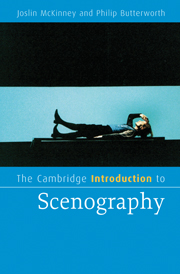Book contents
- Frontmatter
- Contents
- List of illustrations
- List of boxed quotations
- Preface
- Acknowledgements
- Part 1 Elements
- Part 2 Processes of scenography
- Chapter 3 Text as conditioner of image
- Chapter 4 Recognising and realising space
- Chapter 5 Technology as performance
- Part 3 Realisation and reception
- Notes
- Bibliography
- Index
- Cambridge Introductions to …
Chapter 3 - Text as conditioner of image
Published online by Cambridge University Press: 05 February 2015
- Frontmatter
- Contents
- List of illustrations
- List of boxed quotations
- Preface
- Acknowledgements
- Part 1 Elements
- Part 2 Processes of scenography
- Chapter 3 Text as conditioner of image
- Chapter 4 Recognising and realising space
- Chapter 5 Technology as performance
- Part 3 Realisation and reception
- Notes
- Bibliography
- Index
- Cambridge Introductions to …
Summary
The relationship between text and image in performance has been central to scenographic practice in the twentieth century. Although several pioneers actively resisted the play text as the leading component, others, such as Appia, Neher, Mielziner and Svoboda, explored ways in which scenography and text could be interdependent. This chapter sets out some of the ways in which this interdependence can be conceptualised. It is important to draw upon wider historical and contemporary examples to identify key conceptual frames which chart connections between play text and scenographic image in order to put some of the pioneering work into context.
Mielziner's collaborative work with playwrights Arthur Miller and Tennessee Williams involved close working relationships in which practical staging solutions and evocative scenographic environments emerged from the themes and images of the play text in such a way as to allow the words to resonate and take on additional layers of meaning. However, collaboration between designer and playwright does not always lead to aesthetic fusion; it may lead to a different kind of interaction. For instance, Caspar Neher worked closely with Brecht as the play text and scenography developed simultaneously. However, Neher's scenography developed in parallel with the text and was designed to comment on it. Text and scenography were required to share the political purpose of Brecht's productions and yet develop distinct and independent means of fusing their contribution.
- Type
- Chapter
- Information
- The Cambridge Introduction to Scenography , pp. 83 - 103Publisher: Cambridge University PressPrint publication year: 2009



